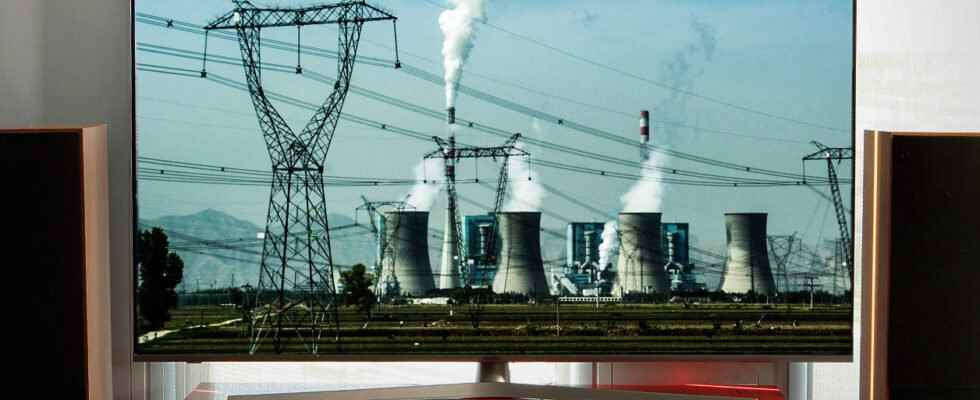The most controversial high-tech object for its impact on the environment is undoubtedly the smartphone. Companion of our daily life, it federates all the criticisms and all the information campaigns to better recycle it. And that’s commendable. However, it is far from being the worst of our equipment.
The first joint study by Ademe and Arcep on the environmental footprint of digital technology in France attests to this. It contains a rather edifying graph on the distribution of impacts according to the devices.
The crushing weight of screens
On most of the indicators, screens and audiovisual equipment are the main culprits (between 17% and 46%). It should be noted right away that this category includes, of course, private workstations but also computer monitors, security monitors and display devices in shops, transport, or even in classrooms with blackboards. smart. It also includes TV boxes and video projectors.
The detailed study by Ademe and Arcep makes it possible to isolate the only televisions within this category. When we look in detail, the effects of video projectors and boxes are almost marginal. And it is the televisions that increase the bill. They concentrate from 11 to 30% of the impacts of all digital devices.

They particularly weigh on the depletion of natural abiotic resources (30%), the production of waste (28.60%), the consumption of primary (20.40%) and final energy (20.70%), radiation ionizing (20.10%).
If we compare the effects of televisions and those of smartphones, we will observe that televisions are more harmful overall for the environment and on a greater number of indicators. But precisely concerning climate change, the palm goes by a short head to smartphones whose share amounts to 14.30% against 13.70% for televisions.
The problem is the size of the TVs
The situation is apparently paradoxical. Televisions have a longer renewal cycle and are sold less massively than smartphones. Their lifespan is six to eight years on average compared to 2.5 years for a smartphone. There would also be around 43 million televisions in circulation in our country compared to 62 million smartphones. How then can their greater harmfulness be explained?
The main problem is their size. And as with all digital equipment, it is the manufacturing stage that is the most problematic. The extraction of minerals, their transformation into electronic components, the production of screen panels contribute to this heavy toll.
Frédéric Bordage, expert from the Green IT collective and founder of the site of the same name, took part in the study by Ademe and Arcep. He has been studying the impact of digital for many years. And he’s seen TV sizes explode in recent years.
“Our reference size for screens was 31 inches in 2010, 47 inches in 2018, and we should reach 65 inches in 2025”, he told us.
However, the manufacture of a 47-inch television emits 479 kg of greenhouse gases and requires 26,000 liters of water!

Towards software obsolescence?
At the same time, screen equipment tends to intensify. They are now present in several copies within the same household, enthroned in the corridors of the metro, in waiting rooms, or in the street.
Another problem is the development of smart TVs. They are real small computers with operating systems and updates. Their renewal cycle could be shortened due to software obsolescence. This is what the association Hop (Stop planned obsolescence) already pointed out with its report on televisions and its appeal to manufacturers to make them more durable last June.
Finally, it should be noted that the energy consumption of televisions has been soaring since 2019 after a long period when it had fallen.
“There are several factors that come into play: technology (OLED consumes less, for example), definition, brightness settings, wallpapers, etc. But overall, the more pixels there are, the more it consumes », Frédéric Bordage tells us again.
Also see video:
What solutions?
The Hop association has drawn up a substantial list of improvements needed to extend the life of televisions, such as better sizing the diodes or ensuring the complete disassembly of the panel. But it would also be appropriate to intervene from the design of the device.
“To do well, you would need modular equipment. And start by concentrating the intelligence of a smart TV in a single exterior box. Thus dissociated, the TV would not need to be changed with each technological innovation., assures Frédéric Bordage.
It would also be a question of encouraging the collection and reuse of televisions, two points which leave something to be desired compared to smartphones. No doubt it would be necessary to make users aware of all these aspects. Why not introduce a bonus/penalty depending on the size of the screens?
Let’s remember a few useful daily gestures: do not leave the televisions on all the time, reduce the brightness of the screen or the quality of streamed streams. And of course, don’t rush to change your screen at the introduction of the slightest novelty.
If it will be necessary to educate users, it will also be necessary to get the message across to manufacturers, who update their ranges every year. A challenge of innovation and economic growth for these giants, which prevails, to the detriment of longer-term ecological thinking.
Contacted about the environmental footprint of televisions last summer, the French teams of manufacturers Sony and Samsung did not respond to our interview requests.
Sources: The Ademe/Arcep study, Hop’s report, Green IT website
